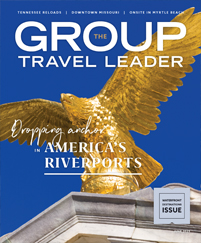Maybe they are still working and have little vacation time. Maybe they are retired but unwilling to be away from home for a long stretch. Either way, most American travelers cap their vacations at two weeks, and many are looking for even shorter trips. From shaving days off itineraries to shifting tours to take advantage of weekends, tour operators are finding new ways to accommodate time-pressed travelers.
Goway Travel
In years past, even as recently as the early 2000s, it was “work, work, work; I can’t take any time off; I can’t go,” said Barbara Norton, general manager for Goway Travel’s groups department. But now, she said, people are recognizing the importance of work-life balance, so it’s not such a hard sell to get people to buy tours, especially shorter trips that fit with their schedules.
“They want to go — they’re more willing to spend the money — but they want to travel for shorter times because they only have the two weeks,” Norton said. “It’s not just baby boomers; it’s also millennials. They have the money, and they want to spend it, but they do only have two weeks because they’re just starting out.”
Goway markets to all travel segments, from the backpacker to the luxury traveler. But within that budget sector, the company also targets those who don’t have the luxury of time, Norton said.
Goway has an islands program that works well for people who want shorter getaways; the program offers several seven- to 10-day products to Fiji, Tahiti and the Cook Islands.
The company also recently tweaked its Magic of Africa tour for 2015, to shorten it from 16 days to 12 days, in part because “people didn’t want to go for so long,” Norton said. Whether it’s the group or FIT market, South Africa can be done in 12 to 14 days without feeling “like you need a holiday when you get home,” she said, although she added that Africa would probably be the limit for Goway’s two-week programs.
“We’re trying to change that whole perception of long haul, that ‘I need two, three weeks,’” she said. “No, you don’t need that much time. You can go for seven days and relax, and you won’t spend all your time in a plane.”
When marketing to the working traveler, it’s important they know they won’t be rushed, that the trip will be well paced, and that they will have the time to see and do what they want, all in a budget they can afford, Norton said.
“We can’t change the distance to some of the destinations; it’s just getting the word out that ‘long haul’ and ‘overseas flight,’ all those words that conjure up time, are still doable,” she said.
Travelers with limited time are also recognizing the value of Central and South American countries, such as Costa Rica and Colombia, because they’re in the same time zones as the United States and the flights are fairly short, she said.
Another up-and-coming destination is Iceland, where Goway launched tours this year. The country has become more accessible with direct flights, which take only four hours from New York, Norton said.
G Adventures
As a multinational company, G Adventures sees travelers from all over the world. But how long people travel on each trip, in large part, depends not necessarily on whether they’re still working but rather on where they’re coming from. British and Australian travelers, for example, have much more vacation time to spend traveling than Americans do.
“Americans — not only when we’re working do we not have much time, but even retired people want to max out at two weeks,” said Lucas Bialecki, U.S. groups business development manager for G Adventures. “Most Americans are not OK with being away from home more than two weeks.”
However, Americans are “making more time for travel,” and companies are being more flexible with their employees, he said. Bialecki has noticed that companies are realizing how important travel is to their employees, and management is starting to understand that taking time off “doesn’t make [employees] less productive; it makes them more productive,” he said. Workers come back from travel refreshed and ready to go, which benefits everyone, he said.
G Adventures has a feature on its website that allows people to search trips by duration. The company has nearly 700 itineraries in more than 100 countries on every continent, so “we definitely have a lot of product for people who are still working and only have limited time,” Bialecki said.
G Adventures offers a “crazy range” of trips, from a 54-day African journey to a six-day tour of Alaska’s Kenai Peninsula, Bialecki said, so there are itineraries for every schedule.
Americans’ aversion to lengthy trips isn’t the only cultural difference; U.S. travelers also tend to want a bit more comfort on their journeys, Bialecki said. For those travelers, G Adventures’ “Comfort” and “Active” travel styles are good fits because both are designed to provide authentic experiences — snorkeling in the Galapagos Islands or hiking the Great Wall of China — while delivering more comfort, he said.
Another product that working travelers enjoy is G Adventures’ Local Living tours, which are typically seven to eight days long. Instead of staying at a hotel, travelers live like the locals in a country house or a villa, or even an apartment. Although tour options include staying in a mud hut with the Maasai Mara tribe in Kenya or staying in a “ger” with the nomads of Mongolia, most American travelers opt for the Local Living tours in Europe. The Amalfi Coast is especially popular, Bialecki said.
North American travelers squeezed for time are also flocking to Peru and Costa Rica, he said. The company’s seven-day Inca Trail tour takes people to Machu Picchu, and travelers have the option to extend it to nine days, bookending the trip with two days in Lima.











